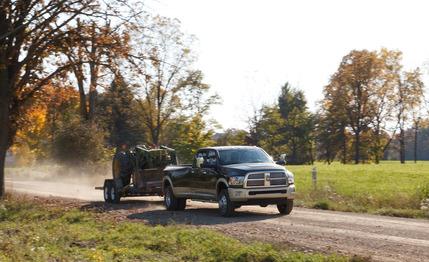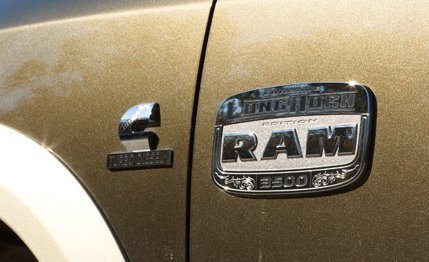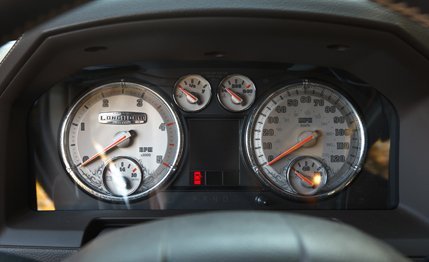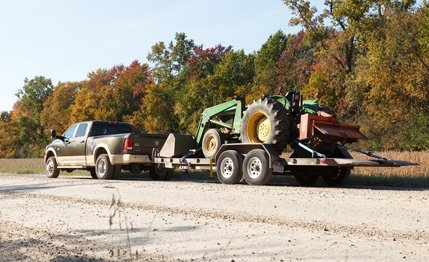 Short Take Road Test
Short Take Road Test

Subtlety is the great weakness of heavy-duty trucks. It’s hard to go unnoticed in a vehicle that simultaneously crowds both edges of its lane and has a hood as high as the roofs of other cars. For all their outward conspicuity, though, HD haulers are a lot like any other truck inside. But Ram’s Laramie Longhorn package, new for 2011 and available on the full range of 1500, 2500, and 3500 trucks, succeeds handily in changing that.
There are few exterior cues to its specialness (we’re not counting the belt-buckle-sized fender badges, as most trucks today wear some similar exterior decoration), but inside the Longhorn, it looks and smells like Kentucky’s finest tack room exploded. The seats of our truck are swaddled in pebbled brown leather embellished with filigrees on the thigh and side bolsters. The white gauge faces bear additional flourishes with similar markings on the trim rings. Contrasting tan stitching adorns the leather on the steering wheel and shifter, and the doors and the enter stack are trimmed in burled walnut. A barbed-wire pattern is molded into the floor mats, which feature genius snap-out carpet swatches—easy to clean, but even easier to avoid soiling with a muddy boot by simply removing them. The barbed-wire theme is a bit much. The Longhorn’s masterstroke is on the front seatbacks, where thick flaps of leather hang down to cover the map pockets. Although everyday magnetic clasps hold them closed, heavy faux belt buckles appear to be doing the work.

Longhorn trucks also have about every option offered on lesser Rams, including navigation, a rearview camera, a flip-down screen for rear-seat entertainment, and heated seats at all four corners with cooling for the front occupants. Ford previously stood alone in the super-luxury pickup arena with its sumptuous King Ranch trim, but Ram looks to have surpassed it. We now eagerly await GM’s response. GMC’s Denali trucks don’t count, since a proper challenger has to look and smell like a new saddle.
We’re Not Going Soft
As much as we love the crazy interior treatment, though, we had another reason to scope out this Ram: After last summer’s diesel-output skirmish between GM and Ford, Ram was left playing catch-up. (Quick recap: Ford debuted a new Power Stroke turbo-diesel making 390 hp and 735 lb-ft of torque; just days later, GM claimed 397 hp and 765 lb-ft for its new Duramax turbo-diesel. A few months after that, Ford rolled out an update that brought its tugboat to 400 hp and 800 lb-ft.) And so in February, Ram announced that it would be boosting the Cummins inline-six in its heavy-duty Ram 2500 and 3500 to a beastly 800 lb-ft of torque using a new powertrain control module. The increased output is only available with the six-speed automatic transmission—which now sports a beefier torque converter to handle the strain—and adds $500 to the $1100 cost of the trans.
Our now-departed long-term Ram 2500 diesel weighed 7620 pounds; this truck carries an extra 480, for a total of roughly 8100 pounds. (That figure might be a couple pounds high, because we weighed the truck dirty. It was a light coating of mud, but there’s a lot of sheetmetal here.) Our test results show that the extra output makes a difference. The 3500 matched our lighter, single-rear-wheel long-termer to 60 mph, at 8.4 seconds, and lost a second to 100 mph, 27.1 to 26.1. In other metrics, it neatly split that truck’s initial and final braking distances, with a 207-foot screech from 70 mph to 0, and howled around the skidpad at 0.68 g compared with the long-termer’s best of 0.74.
Knock, Knock. Who’s There? Five Tons. Really?
Resigned to using the truck for its intended purpose—towing—we sought the heaviest load we could easily procure, which turned out to be about 10,000 pounds, or less than half the Ram’s maximum of 22,700 using the fifth wheel. (Our trailer was hooked to the bumper.) Five tons of trailer didn’t noticeably affect the Ram’s behavior on the road; there was no wandering, no bouncing, no wagging. We had to constantly remind ourselves not to drive as we normally do, or at least build back up to that behavior carefully. And when we did forget and needed to slow abruptly, the exhaust brake’s efficacy seemed to increase in direct proportion to trailer weight. It made an appreciable difference with a 7100-pound warm-up load behind the truck, but when we hooked up five tons, the Longhorn’s off-throttle drag reminded us of an electric car aggressively scavenging energy for its batteries.

The ease with which the Ram pulls a load makes even daily commuting similarly burdened not particularly intimidating—which is why we did it for a day. In Ann Arbor, that meant a wake-up call for the defeated legions in their Priuses as a tractor on a trailer behind a truck effortlessly surged past. Parking—already difficult in a vehicle measuring more than 21 feet long and 8 feet wide—was our only real problem.
An Unrecognized Status Symbol
Our one complaint about the Longhorn is its cost. Not that it’s comparably high, since our as-tested price of $61,930 is about where diesel HD trucks from Ford and GM top out, too. Instead, our issue is this: If fellow commuters were aware of the sticker price, a lot more of those “How’d he do that?” looks as we slithered through traffic would have been followed by a breathy “And who the heck is he?” Maybe Ram should put some tooled leather and buckles on the outside. People are going to take notice one way or the other—might as well make them wonder.
